Pool Safety
Foot Safety: How to Protect Your Feet at the Swimming Pool
Care for your feet at the pool by wearing swim shoes, checking for cuts, and practicing good hygiene to prevent infections and injuries.

Protect your feet at the swimming pool by wearing swim shoes to prevent cuts, infections, and slips on wet surfaces. Check for cuts before swimming and dry feet thoroughly afterward. Use a personal towel to avoid fungal infections and wash it regularly. Post-swim, wash feet with clean water, especially between toes, and make sure they are completely dry. Stretch before swimming to reduce foot strain and stay hydrated to prevent cramps. Prioritize foot hygiene and pay attention to swimming techniques to avoid injuries. Consider using water shoes or flip-flops as a barrier against contaminated pool surfaces for optimum foot safety.
Key Takeaways
- Wear water shoes to prevent infections and slips.
- Check feet for cuts before swimming.
- Dry feet thoroughly after swimming.
- Stretch to reduce foot strain risks.
- Avoid walking barefoot on wet pool surfaces.
Common Foot Injuries at Pools
What foot injuries are commonly encountered at pools?
When at swimming pools, it's important to be aware of the common foot injuries that can occur. Plantar warts and athlete's foot are infections often contracted in such environments due to the warm and moist conditions. These conditions provide a breeding ground for bacteria and fungi, leading to foot discomfort and potential infections.
Additionally, performing swimming strokes and wall pushes can strain foot muscles, resulting in foot cramps and other related injuries. Walking barefoot on wet pool surfaces also poses a risk, increasing the chances of slips and falls, which can cause minor to severe foot injuries.
It's vital to be cautious and take preventive measures such as wearing water shoes, checking feet for cuts or blisters before entering the pool, and ensuring that your feet are dry post-swim. By being mindful of these common foot injuries, you can better protect yourself and enjoy a safer pool experience.
Choosing the Right Footwear

Consider wearing swim shoes to protect your feet effectively while at the swimming pool.
When choosing the right footwear for pool activities, keep in mind the following tips to guarantee maximum foot safety and comfort:
- Opt for swim shoes: These specialized shoes are designed to protect your feet from cuts, infections, and slips commonly found at swimming pools.
- Choose rubber-soled shoes: Look for swim shoes with rubber soles as they provide better traction on wet surfaces, reducing the risk of slips and falls.
- Ensure water-resistance: Select water-resistant footwear to prevent fungal infections like athlete's foot, which thrive in moist pool environments.
Towel & Pool Hygiene Tips

Using a personal towel at the pool is essential to prevent the spread of fungal infections.
Regularly washing your towels helps eliminate bacteria and germs that can lead to skin issues.
Remember to pat your feet dry thoroughly with a clean towel to avoid moisture-related foot problems.
Towel Cleanliness Importance
Regularly washing your towels is essential for maintaining proper hygiene at the swimming pool. Clean towels play an important role in preventing the spread of bacteria and fungi, ensuring a safe and healthy environment for all pool-goers.
Here are some important points to keep in mind regarding towel cleanliness:
- Preventing Skin Infections: Using a clean towel helps reduce the risk of skin infections that can result from bacteria lingering on dirty towels.
- Maintaining Hygiene: Regular washing of towels keeps them free from harmful bacteria, promoting good hygiene practices at the pool.
- Feeling Fresh: A fresh towel not only prevents the transfer of germs but also leaves you feeling clean and refreshed after your swim.
Feet Drying Techniques
After swimming, always make sure you carefully pat your feet dry with a clean, dry towel to prevent fungal infections. Moist environments, like those found at swimming pools, can harbor bacteria and fungi that thrive in damp conditions. By thoroughly drying your feet, you reduce the risk of developing conditions such as athlete's foot.
Remember not to share towels with others to avoid transferring any potentially harmful microorganisms. It's also a good practice to rinse off your feet with clean water after leaving the pool to remove any chlorine or other chemicals that could irritate your skin.
Ensuring your feet are completely dry before putting on socks and shoes is essential in preventing moisture-related foot issues. By following these foot care tips and maintaining proper pool hygiene, you can protect your feet from infections commonly associated with damp environments.
Post-Pool Rinse Off
Thoroughly rinse off your feet after leaving the pool to remove chlorine, bacteria, and other contaminants. Here are some essential steps to make sure your feet stay clean and healthy post-swimming:
- Use clean water: Wash your feet and between your toes with clean water to prevent infections and irritation.
- Dry completely: Be sure to dry your feet thoroughly, especially between the toes, to avoid fungal growth in damp areas.
- Pat dry gently: After rinsing, pat your feet dry gently with a clean towel to prevent skin irritation or damage.
Drying Techniques for Feet

After swimming, remember to thoroughly dry your feet to prevent fungal infections and skin irritation. Use a clean towel to gently pat your feet dry, ensuring you reach between the toes.
Avoid leaving your feet damp, as moisture can create an environment for bacteria and fungus to thrive.
Towel Drying Tips
To guarantee excellent foot hygiene post-swimming, employ efficient towel drying techniques to prevent fungal infections and moisture buildup.
Here are some towel drying tips to keep your feet dry and healthy after a day at the swimming pool:
- Always use a separate, clean towel specifically for drying your feet to avoid spreading bacteria and fungi.
- Make sure to gently pat your feet dry, paying extra attention to areas between the toes where moisture can accumulate.
- Confirm your feet are completely dry before putting on socks and shoes to prevent the growth of bacteria.
Air Drying Methods
When it comes to drying your feet after swimming, utilizing air drying methods is an important way to maintain foot hygiene and prevent fungal infections. Keeping your feet clean and dry is essential in avoiding issues like athlete's foot. Air drying allows excess moisture to evaporate naturally, reducing the risk of fungal infections.
Properly drying between your toes is particularly vital as it helps prevent conditions like athlete's foot and other foot infections. Instead of rubbing your feet vigorously with a towel, consider gently patting them dry with a clean towel to maintain foot hygiene at the pool. By allowing your feet to air dry without trapping moisture, you can prevent bacterial growth and skin irritation.
Thoroughly drying your feet after swimming not only enhances comfort but also plays a significant role in preventing fungal infections and maintaining overall foot health.
Footwear Selection Advice
For effective foot hygiene and moisture prevention, selecting swim shoes made of quick-drying materials is essential. When choosing your footwear for the pool, keep the following advice in mind:
- Quick-Drying Materials: Opt for swim shoes that are specifically designed to dry rapidly, reducing the risk of moisture buildup and the development of fungal infections.
- Non-Slip Soles: Look for swim shoes with non-slip soles to guarantee traction on wet surfaces, helping you avoid slips and falls that could lead to foot injuries.
- Breathable Designs: Consider swim shoes with breathable designs to promote airflow and keep your feet dry and comfortable, preventing discomfort and potential skin issues.
Hydration & Stretching Tips

Stay adequately hydrated before and after swimming to prevent foot cramps and dehydration-related injuries, ensuring peak foot performance at the pool. Essential hydration is important for maintaining foot health and overall performance in the water. Drinking enough water helps prevent muscle fatigue and supports your feet during swimming activities.
Additionally, stretching your feet and ankles before hitting the pool can enhance flexibility, reducing the risk of strains and injuries. Stretching is an essential practice that can also help in avoiding foot cramps and ensuring a more enjoyable swimming experience.
Preventing Strains & Injuries
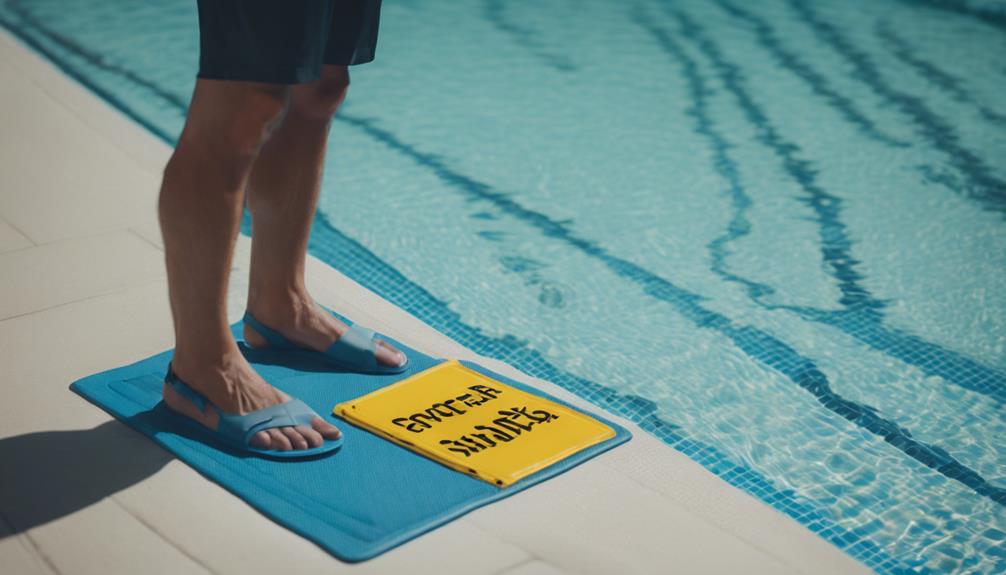
To prevent strains and injuries while swimming, focus on proper warm-up techniques and maintaining good hydration levels. Stretching before entering the pool helps prepare your muscles and reduce the risk of foot strains. Additionally, staying hydrated and consuming foods rich in calcium can help prevent foot cramps during your swim.
Here are three key tips to avoid foot injuries:
- Pay attention to your swimming techniques to prevent overuse injuries and strains.
- Take regular breaks to prevent overexertion and listen to your body's signals.
- Wear swim shoes or water socks to reduce the risk of slips, falls, and related foot injuries.
Safety Measures for Pool Surfaces
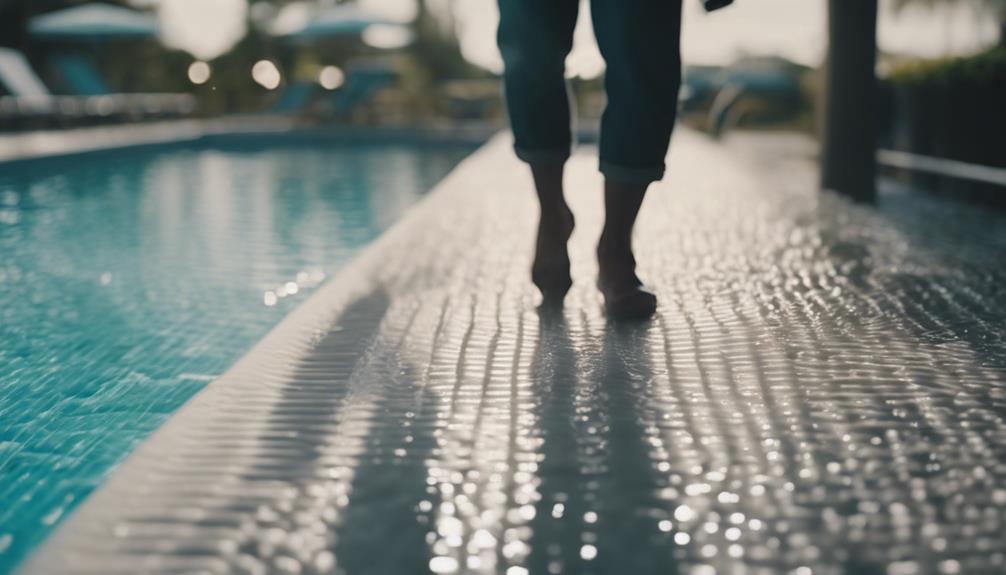
Pay attention to the potential risks posed by pool surfaces, especially in tropical or humid climates where contagious bacteria and fungi can thrive. Pool surfaces can harbor harmful bacteria and fungi, increasing the risk of infections like athlete's foot and plantar warts caused by HPV.
To protect your feet, prioritize foot hygiene by washing them thoroughly after swimming and ensuring they're completely dry before wearing socks and shoes. Consider wearing water shoes or flip-flops around the pool to create a barrier between your feet and the potentially contaminated surfaces.
Additionally, avoid sharing towels to prevent the spread of infections. Remember to rinse off well after leaving the pool to remove any lingering contaminants.
Frequently Asked Questions
How to Treat Pool Feet?
To treat pool feet, start by cleansing them thoroughly with antibacterial soap and warm water to remove bacteria and fungi.
Use foot scrubs or pumice stones to exfoliate dead skin and prevent calluses.
After cleansing, apply a moisturizing foot cream or lotion to keep your feet hydrated and prevent dryness.
For cracked heels and rough skin, use healing balms or ointments to promote skin repair.
Maintain regular foot care routines to guarantee soft, healthy skin and prevent infections.
How to Avoid Foot Fungus at the Pool?
To avoid foot fungus at the pool, always wear flip-flops. Fungal infections thrive in warm, damp areas, like poolside.
Athlete's foot and plantar warts are common pool-related issues. These can cause itching, burning, and hard growths on your feet.
What Do You Wear on Your Feet in the Pool?
When hitting the pool, opt for swim shoes to safeguard your feet from rough surfaces and potential infections. Avoid going barefoot to dodge cuts, infections, and slips.
Choose pool shoes with non-slip soles for better traction and protection. Guarantee a snug fit to prevent blisters and discomfort.
Proper pool footwear acts as a barrier against athlete's foot and plantar warts. Prioritize foot safety and enjoy a worry-free swim.
How Can I Protect My Feet From Water?
To protect your feet while swimming, consider wearing swim shoes or water shoes to prevent cuts, scrapes, and infections. Applying waterproof sunscreen can shield your feet from sunburn and skin damage. After swimming, be sure to rinse your feet thoroughly to eliminate chlorine or bacteria. Avoid walking barefoot on wet pool decks to reduce slips and falls. Remember to regularly check your feet for cuts, blisters, or signs of infection for prompt attention.
Conclusion
In summary, prioritizing foot safety at the swimming pool is vital to prevent common injuries and guarantee a pleasant experience. Remember to choose appropriate footwear, maintain proper hygiene, and practice post-pool rinsing and drying techniques.
Stay hydrated, stretch regularly, and be mindful of strains and injuries. By following these safety measures and being cautious of pool surfaces, you can protect your feet and enjoy your time at the pool with peace of mind.
Pool Safety
How to Get a Disabled Person Into a Swimming Pool
Bring accessibility to the pool for disabled individuals with innovative solutions that ensure safe and easy entry.
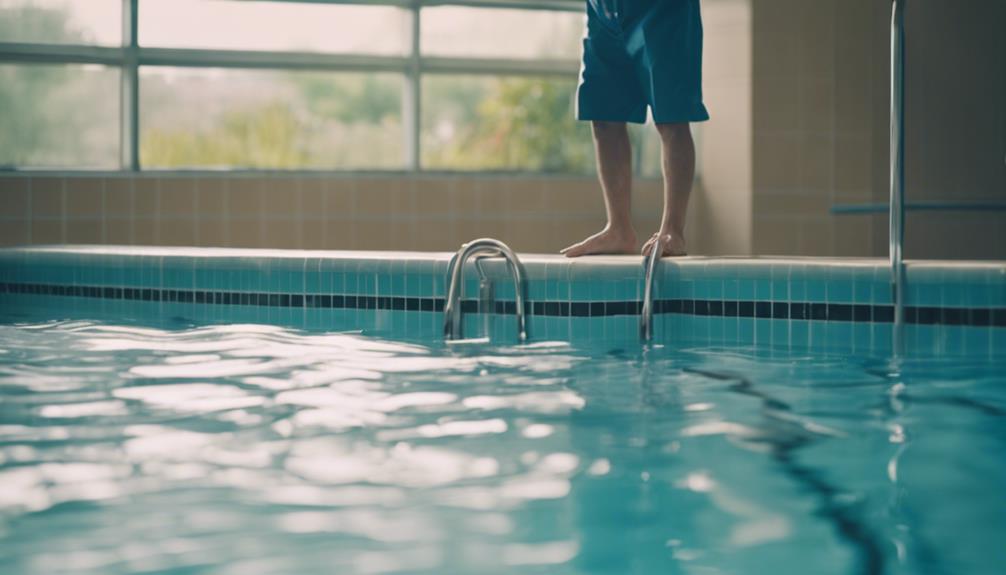
To help a disabled person access a pool, consider using pool lifts, motorized ladders, steps with handrails, and submersible wheelchairs designed for such purposes. Pool lifts offer wheelchair users ease of entry, while motorized ladders aid in smooth access. Handrails on step ladders provide added support, and submersible wheelchairs allow for comfortable aquatic experiences. Maintenance and installation guidelines are essential for safe and efficient use. Additionally, guarantee proper equipment, techniques, and communication for secure transfers. Seeking assistance when needed ensures a hassle-free experience. Explore the outlined options for enhanced pool accessibility.
Key Takeaways
- Use pool lifts for safe and easy entry.
- Consider motorized ladders or adapted lifts.
- Ensure handrails and stability features are available.
- Utilize submersible wheelchairs for pool access.
- Implement customized lift solutions for diverse needs.
Pool Lift Options for Accessibility
When considering pool lift options for accessibility, choosing the right equipment is vital for guaranteeing a safe and convenient experience for individuals with disabilities. Pool lifts play an essential role in providing wheelchair users with a seamless transfer from their wheelchair into the pool, ensuring a secure entry.
These lifts are designed to raise, rotate, and lower users into the pool water, offering a comfortable experience. Many pool lifts also come equipped with securing straps to guarantee safe rotation and can be controlled independently by the user, enhancing convenience and autonomy.
It is important to select a pool lift that meets safety standards and offers the necessary features for a smooth shift into the pool. By providing individuals with disabilities access to pool lifts that are reliable and user-friendly, you can help create an inclusive environment where everyone can enjoy the benefits of swimming without barriers.
Motorized Automatic Ladder Features

Consider opting for a motorized automatic ladder to assist individuals with mobility difficulties in accessing the swimming pool effortlessly.
This type of ladder is controlled by an easy-to-use command button, allowing users to position themselves on the motorized step for safe entry into the pool.
With only one step for descent, the motorized automatic ladder is ideal for users who struggle with traditional ladders. This feature provides a practical solution for those needing assistance with pool access and entry.
By choosing a motorized automatic ladder, individuals with mobility challenges can enjoy the pool without the hassle of moving through difficult entry points.
The convenience and safety offered by this type of ladder make it a valuable addition to any pool area, ensuring that everyone can access and enjoy the pool environment comfortably.
Step Ladder With Handrail Benefits

A step ladder with a handrail offers stability, making it easier for individuals to access the pool safely.
The handrail provides assistance for those who may need extra support, ensuring a secure entry into the water.
With these features, users can enjoy swimming with added safety and peace of mind.
Handrail for Stability
The step ladder with handrail provides essential stability and support for individuals with reduced mobility when accessing the swimming pool. This feature is particularly beneficial for older users or those who may struggle with balance or strength issues.
Here are some key points to take into account regarding the handrail for stability:
- The wide, anti-slip steps on the ladder guarantee safe and secure pool access, reducing the risk of slips or falls.
- Handrails can be equipped on one or both sides of the ladder, offering constant support and grip for added security.
- The handrail enhances safety by providing a secure grip while entering and exiting the pool, allowing individuals to feel more confident and stable.
- This adapted ladder is ideal for individuals who need extra assistance for pool access, making it a valuable addition for those with mobility challenges.
Easy Access Assistance
Enhance your pool accessibility with the step ladder featuring a supportive handrail for added stability and safety. This pool access solution is designed with wide, anti-slip steps to guarantee a safe entry into the swimming pool.
For individuals requiring extra support, the step ladder can be equipped with one or two handrails, providing the necessary assistance for a secure pool access experience. Particularly beneficial for older individuals or those with reduced mobility, the handrail guarantees constant support and grip during pool entry, ensuring a smooth shift into the water.
The adapted design of the step ladder with handrail offers a secure and stable way for disabled individuals to access the pool, promoting inclusivity and independence. With its safety features and easy-to-use design, the step ladder with handrail facilitates smooth and secure pool access for users of all abilities, making it an essential component in enhancing pool accessibility alongside other options like pool lifts.
Safety in Water
Considering the safety benefits, step ladders with handrails provide a secure and stable solution for individuals with mobility difficulties to access the swimming pool. These specialized ladders offer essential support and stability, enhancing safety in and around the pool water.
Here are some key advantages of step ladders with handrails:
- Wide, anti-slip steps guarantee secure footing when entering or exiting the pool water.
- One or two handrails provide constant support and grip for added stability.
- Adapted for older users or those with reduced mobility, these ladders cater to a diverse range of individuals.
- Handrails on the ladder offer an extra layer of security, minimizing the risk of slips or falls in the pool water.
Submersible Wheelchair Advantages

With water access being a challenge for individuals with reduced mobility, submersible wheelchairs offer a practical solution. These specialized wheelchairs not only provide a means for individuals to access public pools but also come with several advantages that facilitate a safe and enjoyable aquatic experience.
| Advantages of Submersible Wheelchairs | ||
|---|---|---|
| 1. Gradual Immersion | 2. Adapted Heights | 3. Lightweight |
| Allows for a comfortable and safe entry into the pool | Designed for easy sitting and maneuvering in water | Facilitates easy movement in and out of the pool |
| 4. Aquatic-Use Wheels | 5. Inclusive Access | |
| Equipped with wheels suitable for aquatic environments | Ensures all individuals can participate in aquatic activities |
Submersible wheelchairs enable individuals with reduced mobility to access public pools safely and comfortably, promoting inclusivity in aquatic spaces.
Pool Lift Installation Considerations

When installing a pool lift, carefully assess the type of lift needed based on your pool type and ADA regulations for public pools.
For a successful installation, consider the following:
- Pool Type: Determine if your pool is residential or commercial to select the appropriate pool lift model that meets the specific requirements of each setting.
- Space Availability: Evaluate the available space to decide between a fixed or mobile pool lift installation, ensuring it fits seamlessly into your pool area.
- Weight Requirements: Understand the weight capacity needed for the pool lift to safely support individuals during transfers in and out of the pool.
- Cost Variations: Explore the different types of pool lifts available and associated installation costs to make an informed decision that aligns with your budget and needs.
Alternative Solutions for Pool Access
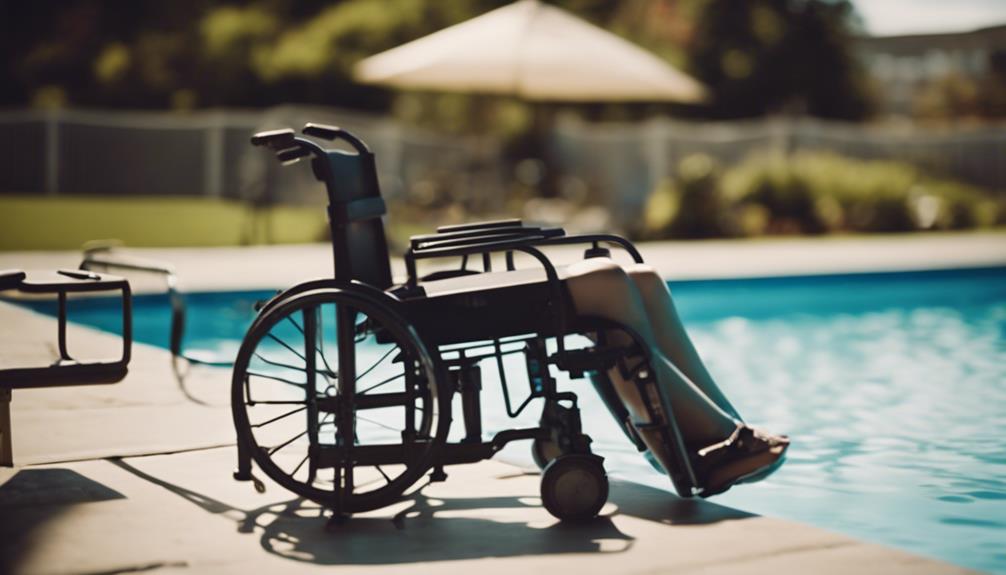
To enhance pool access for disabled individuals, exploring alternative solutions such as customized ceiling lifts can provide innovative and efficient options beyond traditional pool lifts.
Customized ceiling lifts, adaptable for pool use, are increasingly favored for above-ground exercise pools, offering independence and mobility. Lifeway Mobility specializes in tailoring ceiling lifts for pool applications, ensuring safe and convenient access.
The SureHands Freedom Bridge, derived from a ceiling lift design, utilizes a two-post system for elevated lifting requirements, presenting a versatile solution for diverse needs. Considering these adapted pool lifts can greatly enhance accessibility, promoting inclusivity and ease of use for individuals with disabilities.
Submersible Wheelchair Usage Tips

For ideal usage of submersible wheelchairs in the swimming pool, consider the following tips:
- Confirm the wheelchair is properly adjusted to the user's height for comfortable sitting and easy maneuverability in the water.
- Gradually lower yourself into the pool to prevent sudden movements and guarantee a smooth shift into aquatic activities.
- Take advantage of the lightweight design of submersible wheelchairs for easy removal from the water after use, promoting convenience and accessibility.
- Prioritize safety by following any specific instructions provided by the manufacturer for using the wheelchair in the swimming pool environment.
Submersible wheelchairs are valuable tools that enable individuals with mobility challenges to engage in water-based activities comfortably and safely. By adhering to these usage tips, you can enhance your experience in the swimming pool while ensuring top-notch functionality and enjoyment from the wheelchair.
Pool Lift Maintenance Guide

To guarantee the safety and efficiency of your pool lift, it's vital to conduct regular maintenance checks. Start by examining hydraulic fluid levels and condition to prevent any potential malfunctions.
Additionally, inspect moving parts for signs of wear and tear, and remember to clean the lift regularly to avoid dirt and debris buildup.
Lift Safety Checks
Regular safety checks are essential for maintaining the pool lift's functionality and ensuring user safety. To guarantee the lift operates safely, follow these guidelines:
- Regularly inspect the lift components for any signs of wear and tear, such as cracks or loose bolts.
- Verify that all safety features, including securing straps and emergency stop buttons, are functioning correctly before each use.
- Adhere to the manufacturer's maintenance instructions and recommended inspection schedules to prolong the lift's lifespan and maintain safety standards.
- Schedule periodic professional inspections to ensure the lift's overall safety and proper functionality. Professional inspections can identify potential issues that may not be apparent during routine checks and are crucial for ensuring the safety of all users.
Proper Storage Guidelines
Follow proper storage guidelines to maintain the pool lift's functionality and prolong its lifespan. When the pool lift isn't in use, make sure it's stored in a dry, covered area to shield it from potential damage.
Regularly inspect the pool lift for any signs of wear and tear, addressing any issues promptly to guarantee safe operation. It's essential to adhere to the manufacturer's recommendations for maintenance tasks, including lubricating moving parts and checking electrical connections.
To prevent corrosion and maintain battery life, store batteries separately from the pool lift when it isn't in use. Additionally, consider scheduling routine professional inspections and maintenance to keep the pool lift in top condition for safe use.
Frequently Asked Questions
How to Get a Paraplegic in and Out of a Pool?
To assist a paraplegic individual in and out of a pool, consider utilizing pool lifts, motorized automatic ladders, or step ladders with handrails for safe access.
Submersible wheelchairs are also a gradual option for pool entry. These solutions cater to different mobility needs, ensuring secure and comfortable pool access.
For maintenance or spare parts for pool access equipment, our team is available for assistance.
How Do You Make a Pool Accessible?
To ensure a pool is accessible, you need to explore various options like:
- Installing pool lifts with safety features
- Motorized automatic ladders for easy entry
- Step ladders with handrails
Submersible wheelchairs are also a great choice for water access. Ordering spare parts online is convenient, ensuring maintenance and support.
Can You Swim if You're Disabled?
Yes, you can swim if you're disabled. Swimming offers a myriad of benefits for individuals with disabilities, from enhancing core strength to serving as a form of hydrotherapy.
Disabled athletes participate in competitive swimming, showcasing their skills on a global stage like the Paralympic Games. Various disciplines cater to different handicap levels, providing opportunities for athletic achievement and camaraderie.
How Does a Pool Lift Work?
A pool lift operates through a motorized system that allows controlled movement of a seat or platform. The user or caregiver can raise, rotate, and lower the seat into the pool water, ensuring a safe and smooth transfer process.
Safety features like securing straps stabilize the user during rotation, providing essential support for wheelchair users or individuals with limited mobility.
Pool lifts play an important role in granting independent access to pools for disabled individuals.
Conclusion
In summary, ensuring accessibility to swimming pools for disabled individuals is essential for promoting inclusivity and enjoyment.
By utilizing pool lift options, such as motorized automatic ladders, step ladders with handrails, and submersible wheelchairs, individuals can safely and comfortably enter the pool.
Remember, maintaining these accessibility features is key to ensuring continued access for all.
So, take the plunge and make your pool a welcoming oasis for everyone, because inclusivity isn't just a drop in the bucket – it's a tidal wave of change.
Pool Safety
Prevent Swimming Pool Accidents on Cruise Ships
Onboard safety measures are crucial to prevent swimming pool accidents on cruise ships – discover essential tips to ensure a secure and enjoyable voyage.
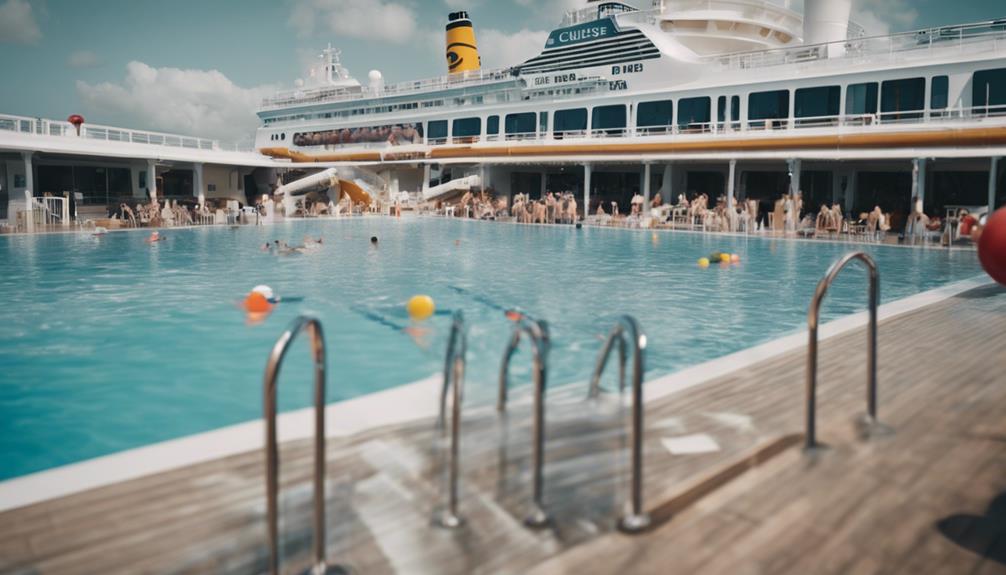
To prevent swimming pool accidents on cruise ships, ensure lifeguards are present for maximum safety. Regular maintenance and easy access to safety equipment like lifebuoys are essential. Enforce capacity limits to avoid overcrowding, reducing accident risks. Clear signage and crew training on safety equipment usage are vital. Implement strict safety protocols, conduct safety drills, and have effective surveillance to minimize drowning risks. Prioritize passenger safety by adhering to guidelines, staying cautious, and knowing pool rules. Quick access to rescue equipment and trained staff is key. Following these measures guarantees passenger safety and an enjoyable cruise experience.
Key Takeaways
- Enforce capacity limits and strict policies to prevent overcrowding and reduce accident risks.
- Ensure lifeguards' presence for immediate response to emergencies and enhanced safety.
- Implement clear signage indicating safety equipment locations, rules, and potential hazards.
- Regularly maintain and inspect safety equipment like lifebuoys and first aid kits.
- Conduct crew training on safety equipment usage and emergency protocols for effective response.
Importance of Lifeguards on Cruise Ships
Acknowledge the important role that lifeguards play in ensuring swimming pool safety on cruise ships. Cruise ships, unfortunately, don't have lifeguards on duty in swimming pool areas. This absence greatly increases the risk of accidents and drowning incidents. Passengers must understand that they bear the responsibility for their safety while using cruise ship pools since lifeguards aren't present.
Families with children, especially, need to provide direct supervision due to this lack of professional oversight. Knowing that lifeguards aren't part of the safety measures on cruise ships can help passengers prioritize their vigilance and adherence to pool safety guidelines.
While cruise ships offer various amenities and activities, it's important to recognize the role of lifeguards in maintaining a safe swimming environment. Their presence can prevent accidents, provide immediate assistance in emergencies, and offer peace of mind to passengers enjoying the pool facilities on board.
Implementing Safety Equipment

Make sure that safety equipment such as lifebuoys, life jackets, and first aid kits are easily accessible near cruise ship swimming pools. Regular maintenance and inspection of safety equipment are vital to prevent accidents and ensure they are in proper working condition. Clear signage indicating the location of safety equipment can help passengers and crew members quickly access them during emergencies. Crew training on how to use safety equipment is essential for improving response times in pool accidents. Implementing safety protocols and conducting drills for using safety equipment can ensure a swift and effective response in emergency situations. Here is a table summarizing the key points related to safety equipment, maintenance, and crew training:
| Safety Equipment | Maintenance | Crew Training |
|---|---|---|
| Lifebuoys | Regular inspection and upkeep | Proper usage training |
| Life Jackets | Ensuring functionality | Quick response drills |
| First Aid Kits | Stocked and accessible | Emergency protocol familiarization |
Enforcing Capacity Limits
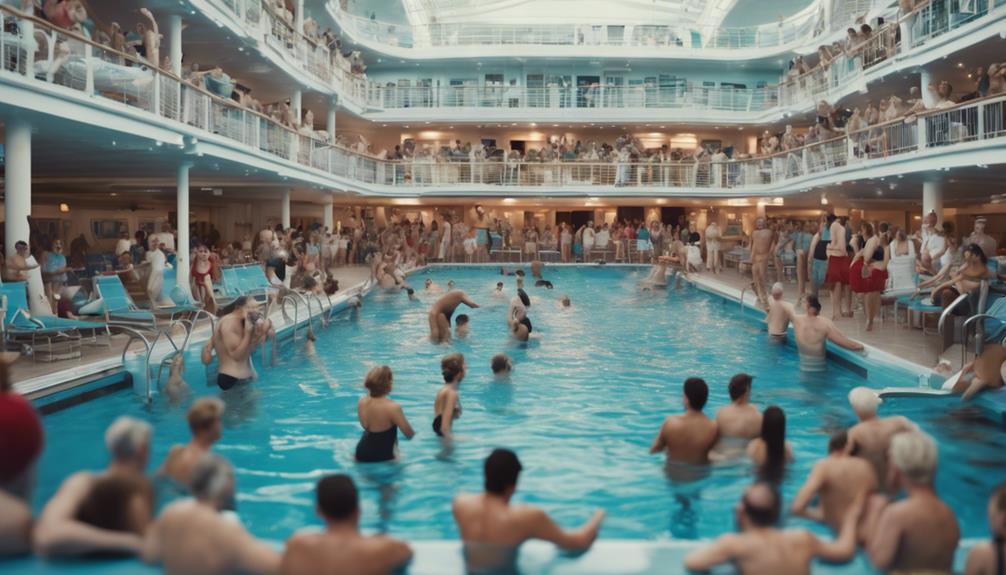
Enforcing capacity limits in swimming pool areas on cruise ships is vital to maintain a safe environment for all passengers. By implementing strict policies and monitoring guest numbers, cruise lines can prevent overcrowding and reduce the risk of accidents.
Capacity control measures are essential in ensuring that there's enough space for everyone to enjoy the pool facilities without compromising safety.
Capacity Control Measures
Implementing capacity control measures in swimming pool areas on cruise ships is essential for ensuring passenger safety and preventing overcrowding incidents. By setting and enforcing capacity limits, cruise lines can maintain a safe environment where guests can enjoy the pool amenities without the risks associated with overcrowding.
Overcrowding in swimming pool areas can lead to chaotic situations and increase the likelihood of accidents occurring, which is why it's vital to monitor and restrict the number of people present. Enforcing capacity limits is a proactive safety measure that contributes to a more enjoyable and secure cruise experience for passengers.
Monitoring Guest Numbers
To maintain a safe environment and prevent overcrowding incidents, it's crucial for cruise ships to actively monitor the number of guests in pool areas and enforce capacity limits.
Overcrowding in swimming pools on cruise ships can greatly increase the risk of accidents and injuries, potentially compromising the safety of all guests. Enforcing capacity limits not only helps prevent accidents but also guarantees a better experience for everyone on board.
Cruise lines must have effective systems in place to control the number of people in pool areas at any given time, allowing for a safe and enjoyable environment around the swimming pools.
By closely monitoring guest numbers and adhering to capacity limits, cruise ships can create a secure setting where guests can relax and have fun without the worry of overcrowding issues.
Strict Enforcement Policies
To maintain a safe environment onboard, cruise lines rigorously monitor and enforce capacity limits at pool areas to prevent overcrowding incidents and guarantee passenger safety. By strictly adhering to these capacity limits, cruise lines can effectively control the number of individuals in pool areas, reducing the risk of accidents such as slip and falls, drownings, and collisions.
This enforcement not only enhances passenger safety but also allows for better hazard management and emergency response protocols in place. Creating a controlled environment through compliance with capacity restrictions ensures that passengers can enjoy a relaxing and secure swimming experience while onboard cruise ships.
It's essential for cruise lines to uphold these policies to maintain a high level of safety and security in high-traffic pool areas, supporting a pleasant and risk-free environment for all passengers looking to unwind and swim during their cruise vacation.
Proactive Accident Prevention Measures

To prevent swimming pool accidents on cruise ships, maintain a constant visible presence of trained lifeguards around pool areas. Pay attention to safety signage and follow their instructions for a safer pool experience.
These proactive measures can greatly decrease the risk of accidents and guarantee a more enjoyable time spent near the water.
Lifeguard Presence
Passengers on cruise ships must take on the responsibility of supervising themselves and their children at pool areas due to the importance of lifeguards not being on duty. It's essential to understand that without lifeguard presence, the responsibility falls on individuals to guarantee their safety and that of their loved ones.
In the event of emergencies, such as someone struggling in the water, passengers need to be prepared to respond promptly and effectively. While some cruise lines have begun to introduce lifeguards, the majority still don't offer this additional layer of protection. Hence, it's essential for passengers to remain vigilant, especially parents, and to establish clear rules for pool safety.
Safety Signage
Implementation of proper safety signage is essential to preventing accidents in cruise ship pool areas. Warning signs play a vital role in alerting Cruise Ship Passengers to potential dangers and promoting a safe swimming environment.
By clearly displaying information such as pool depth indicators and hazard warnings, cruise operators can greatly reduce the risk of incidents and injuries. Lack of adequate warning signs not only jeopardizes passenger safety but also exposes cruise operators to potential liability in case of accidents.
Signage indicating the deep and shallow ends of the pool enables passengers to make informed decisions about where to swim, helping them avoid risky areas. Hence, it's crucial for cruise ships to prioritize the installation of visible and informative safety signage in pool areas.
Proactive measures like proper warning signs are fundamental in fostering a secure environment around cruise ship pools and ensuring the well-being of all passengers.
Reducing Risks of Drownings

Minimize the likelihood of drownings by implementing strict safety protocols and enhancing surveillance measures in pool areas onboard cruise ships. Drownings pose a significant risk, especially in settings where lifeguards are absent. Children, non-swimmers, and individuals under the influence of alcohol are particularly vulnerable to accidents in swimming pools.
To reduce these risks, it's vital to guarantee proper supervision and adherence to safety guidelines at all times. Quick access to rescue equipment and having trained staff readily available can make a pivotal difference in emergency situations. Being aware of potential hazards and staying vigilant while in or around pool areas is key to avoiding tragic incidents.
Enhancing Passenger Safety

To enhance passenger safety around cruise ship pools, prioritizing clear signage and supervision is essential. Cruise ships often lack lifeguards in swimming pool areas, which can increase the risk of accidents for passengers.
By implementing proper safety measures like prominent signage reminding passengers of pool rules and the importance of supervision, cruise lines can greatly reduce the likelihood of incidents. It's vital for passengers to be aware of the potential dangers associated with swimming pool areas on cruise ships and to take precautionary steps to prevent accidents.
Prioritizing personal safety by following guidelines, avoiding risky behavior, and being cautious around pool areas can help passengers enjoy their cruise vacation while minimizing the risk of injuries. Understanding the importance of passenger safety and adhering to safety protocols can make a significant difference in preventing swimming pool accidents and ensuring a safe and enjoyable experience for all aboard the cruise ship.
Frequently Asked Questions
Why Do Cruise Ships Empty the Pools at Night?
Cruise ships empty pools at night primarily for safety and maintenance reasons. By clearing pools, they reduce the risk of accidents, unauthorized access, and unsupervised swimming.
Additionally, nighttime allows for pool cleaning and water quality checks without disturbing guests during the day. Following strict protocols, cruise lines prioritize pool safety and cleanliness.
Pool closures after hours also provide time for rest and preparation for the upcoming day's activities.
How Often Do Cruise Ships Change the Pool Water?
Cruise ships typically change pool water daily or as needed to maintain hygiene and safety standards. Water quality is closely monitored and regulated to prevent bacterial growth and guarantee safe swimming conditions for guests.
Filtration systems aid in water clarity and debris removal, enhancing the overall swimming experience. Regular testing checks chemical levels, preventing health hazards.
Cruise lines prioritize guest safety by adhering to strict protocols for pool water maintenance and sanitation.
Are the Swimming Pools on Cruise Ships Salt Water?
Yes, the swimming pools on cruise ships can vary when it comes to the water content. Some cruise ships have saltwater pools, while others use a mixture of fresh water and seawater to create a saltwater pool experience.
The salt content in cruise ship pools is typically lower than natural seawater for passenger comfort. Both types of pools are regularly maintained and treated to guarantee cleanliness and safety for passengers to enjoy a invigorating swim onboard.
Can You Use Swim Diapers on a Cruise?
Yes, you can use swim diapers on a cruise ship. Most cruise lines allow swim diapers to be worn in their pools. Swim diapers are designed to contain solid waste, but they may not prevent urine leakage.
It's important to check the specific policies of the cruise line you're traveling with. Remember to change the swim diapers regularly to maintain cleanliness and hygiene around the pool area.
Conclusion
To summarize, the significance of implementing safety measures on cruise ships to prevent swimming pool accidents can't be overstated. Just as a lighthouse guides ships safely to shore, lifeguards, safety equipment, and capacity limits can guide passengers to a safe and enjoyable cruise experience.
By taking proactive measures to reduce risks of drownings and enhance passenger safety, cruise lines can guarantee a smooth sailing for all on board. Stay informed, stay safe, and enjoy your cruise responsibly.
Pool Safety
Are Swimming Pool Lights Dangerous? Myths Vs. Facts
Get ready to dive into the truth about swimming pool lights – the myths and facts may surprise you!

Worried about those pool lights? Let's clear it up for you. It's a myth that pool lights are always risky. Sure, faulty wiring or bad installation can cause trouble, but proper setup is key. Remember, water conducts electricity, so play it safe. Using LED lights doesn't mean zero risk. Stick to safety standards like GFCIs for extra protection. Regular checks and maintenance are a must. Want to know more about swimmin'ly safe pool lights? Keep your eyes peeled for deeper insights into this electrifying topic!
Key Takeaways
- Pool lights can be safe with proper installation and maintenance.
- LED pool lights are not immune to electrocution risks.
- Ground Fault Circuit Interrupters (GFCIs) enhance electrical safety.
- Regular inspections and compliance with safety standards are crucial.
- Debunk myths about the dangers of pool lights through proper maintenance.
Common Myths About Pool Lights
When it comes to pool lights, there are several common myths that can mislead pool owners about their safety. One prevalent myth is that pool lights aren't dangerous because they're designed for underwater use. However, the fact is that faulty wiring in the pool lighting system can lead to electrical leaks, posing a serious risk of electrocution.
Another myth suggests that pool lights are safe as long as they aren't touched while swimming. In reality, improper installation and maintenance of these lights can greatly increase the chances of electrical hazards occurring.
It's also a misconception to believe that LED pool lights are completely safe from the risk of electrocution. Regardless of the type of pool lights you have, ensuring proper installation and conducting regular maintenance checks are essential for guaranteeing the safety of everyone enjoying the pool.
Understanding Electrical Safety Standards

Let's talk about electrical safety standards for your swimming pool lights. Understanding these standards is super important to keep you and your loved ones safe while enjoying your pool.
Regular inspections and following the rules can help prevent any electrical mishaps.
Electrical Safety Regulations
To guarantee the safety of swimmers and prevent electrical hazards, understanding and adhering to electrical safety regulations is essential when installing swimming pool lights. Following the National Electrical Code (NEC) and local building codes is vital to confirm the proper installation and maintenance of pool lights. These regulations provide specific guidelines that must be followed to minimize the risk of electrical accidents in and around the pool area. Compliance with electrical safety standards is critical as it helps protect swimmers from potential electrocution risks that may arise from faulty pool lights. By following these regulations, a safe swimming environment is created by reducing the likelihood of electrical incidents related to pool lighting. Check out the table below for a quick overview of some key aspects of electrical safety regulations for pool lights:
| Regulation Aspect | Importance | Compliance Required |
|---|---|---|
| National Electrical Code | Ensures Safety | Yes |
| Local Building Codes | Legal Mandate | Yes |
| Maintenance Guidelines | Prevent Hazards | Yes |
Compliance With Standards
Understanding electrical safety standards is key to guaranteeing the proper installation and maintenance of swimming pool lights. When it comes to pool lighting, compliance with electrical safety standards is essential. Standards like the NFPA 70 (National Electrical Code) outline important requirements for a safe pool lighting setup.
You need to pay attention to details like proper grounding, GFCI protection, and following local building codes to keep your pool area safe and secure.
Don't forget about voltage requirements and the importance of using waterproof fixtures in your pool lighting system. These elements are vital in meeting electrical safety standards and preventing potential hazards.
It's also wise to schedule regular inspections by licensed electricians to ensure your pool lights are up to code and operating safely. By following manufacturer instructions for installation and maintenance, you can maintain compliance with electrical safety standards and enjoy a worry-free swimming experience.
Importance of Inspections
Regular inspections by licensed electricians play a critical role in ensuring compliance with electrical safety standards related to swimming pool lighting systems. These inspections are like giving your pool a thorough check-up to make sure everything is in tip-top shape.
Imagine if your pool had a hidden electrical issue just waiting to cause trouble – inspections help catch those sneaky problems before they become serious hazards.
During these inspections, licensed electricians look for faulty wiring, damaged equipment, or any other signs that could put you at risk of getting zapped. By following national and local electrical codes, these inspections help maintain a safe swimming environment for you and your loved ones.
Plus, including Ground Fault Circuit Interrupters (GFCIs) in the inspection process adds an extra layer of protection against electrical mishaps.
Misconceptions About Water and Electricity

Many people hold misconceptions about the risks associated with water and electricity in swimming pools. Let's clear up some myths to keep you safe around your pool:
- Water and electricity don't mix: Water is a great conductor of electricity, so it's important to be cautious around any electrical devices near the pool.
- Faulty pool lights are no joke: If your pool lights or wiring aren't functioning correctly, they could leak electricity into the water, creating a serious safety hazard.
- Underwater lights can be risky: Those pretty underwater lights are cool, but if not properly installed or maintained, they can pose electrical dangers in your pool.
- GFCIs are your friends: Ground Fault Circuit Interrupters (GFCIs) are like the superheroes of pool safety. They protect your lighting system and circuits from potential electrical threats.
Importance of Proper Installation and Maintenance

Let's discuss why proper installation and maintenance of your pool lights are essential. By ensuring everything is set up correctly and regularly checking for any issues, you can greatly reduce the risk of electrical accidents while swimming.
Installation Safety Tips
For maximum safety, always prioritize proper installation and regular maintenance of your swimming pool lights.
When it comes to installing pool lights, there are some key safety tips to keep in mind:
- Guarantee Proper Wiring: Make sure the wiring for your pool lights is done correctly to avoid electrical hazards. Faulty wiring can pose serious risks, so it's crucial to have it installed by a professional.
- Regular Inspections: Schedule regular inspections of your pool lights to check for any damage or wear. This can help prevent faults that may lead to dangerous situations.
- Utilize Ground Fault Circuit Interrupters (GFCIs): Implement GFCIs in your pool lighting system to protect against electrical leaks. This added layer of safety can prevent accidents and keep swimmers safe.
- Consult a Licensed Electrician: When in doubt, always consult a licensed electrician for pool light installation. They can ensure that the installation is done correctly, following safety regulations and minimizing risks.
Maintenance Best Practices
Regularly maintaining and ensuring proper installation of your swimming pool lights is vital for preventing safety hazards and ensuring peak functionality. Neglecting maintenance can lead to electrical hazards that pose serious risks to you and your loved ones.
By scheduling regular inspections with licensed electricians, you can guarantee that your pool lights are safe and comply with all necessary codes. Faulty wiring or damaged lights can increase the likelihood of electrical leaks, emphasizing the critical need for proper maintenance.
Installing Ground Fault Circuit Interrupters (GFCIs) is essential to protect against potential electrical hazards in your pool lighting system. Additionally, implementing pool bonding, which connects metal components, can further enhance the safety of your pool lighting installations.
Ensuring User Safety With Pool Lights

Make sure to prioritize user safety when it comes to pool lights by conducting regular inspections and maintenance. Ensuring that your swimming pool lighting is in excellent condition is key to keeping everyone safe while having a splashing time in the pool.
Here are a few tips to help you maintain a safe pool lighting system:
- Regular Inspections: Check your pool lights frequently for any signs of damage or wear. Look out for frayed wires, cracked casings, or flickering lights that could indicate a problem.
- Proper Wiring: Make sure that the wiring for your pool lights is correctly installed and insulated to prevent any electrical hazards. Faulty wiring can lead to dangerous situations, so it's crucial to address any issues promptly.
- Use GFCIs: Install Ground Fault Circuit Interrupters (GFCIs) to protect your pool lighting system from electrical faults. These devices help prevent shocks and potential electrocution by quickly shutting off power in case of a ground fault.
- Professional Maintenance: Consider hiring a professional electrician to inspect your pool lights and wiring periodically. Their expertise can help catch any potential issues early on and ensure your pool lighting is safe for use.
Debunking Pool Light Safety Myths

Guarantee you're well-informed by debunking common misconceptions surrounding pool light safety. When it comes to swimming pool safety, faulty pool lights and bad wiring are no joke.
Some might think that as long as the water and electricity stay separate, everything is fine – but that's not the case! Underwater lights and their wiring can be a big electrical hazard in pools.
So, what's the solution? Regular inspection and maintenance are key. Make sure to use Ground Fault Circuit Interrupters (GFCIs) to protect your lighting and circuits. These little devices can be a lifesaver!
Remember, water and electricity are a dangerous duo, especially when it comes to underwater light fixtures. Keep your pool safe and avoid any shocking surprises by staying on top of your pool light maintenance.
Safety first, fun second!
Frequently Asked Questions
Are Swimming Pool Lights Dangerous?
Let's talk about swimming pool lights. They can be risky if not handled right. Faulty wiring and damaged lights can lead to dangerous situations.
You see, pool lights run on electricity, so if they're not set up or taken care of properly, there's a chance of getting zapped. To keep things safe, make sure to install them correctly, maintain them regularly, and use safety precautions.
Stay safe and enjoy your swim!
Are Lights Over a Pool Safe?
Let's talk about lights over a pool. Guess what? When installed correctly, they're totally safe! They actually help you see better and create a cool vibe.
Just make sure to use lights made for wet spots to avoid any electrical issues. LED lights are awesome for pools – they save energy and come in fun colors.
Is It Dangerous to Be in a Pool During Lightning?
So, you know, being in a pool during lightning can be risky. Water conducts electricity, so if a lightning bolt strikes, it can travel through the water and zap you.
It's best to steer clear of the pool when there's a storm brewing to stay safe. Lightning and swimming don't mix well, so it's a good idea to hang out on dry land until the weather clears up.
Stay safe out there!
Are Pool Lights Grounded?
Are your pool lights grounded? Absolutely essential for safety!
Did you know that proper grounding redirects stray currents away from the pool, reducing the risk of electric shock?
Faulty grounding can spell trouble, potentially leading to dangerous situations for swimmers.
Conclusion
So, next time you're chilling by the pool, remember that pool lights aren't as scary as you might think!
By following proper safety guidelines and getting your lights installed and maintained by professionals, you can enjoy your evening swims worry-free.
Don't let those myths get in the way of some well-deserved relaxation time.
Stay safe, stay informed, and keep on swimming!
-

 Relaxation2 months ago
Relaxation2 months agoCreate a Relaxing Oasis: Top Poolside Lounging Ideas
-

 Vetted2 months ago
Vetted2 months ago15 Best Robot Vacuums for Pools to Keep Your Pool Sparkling Clean
-

 Health Benefits2 months ago
Health Benefits2 months agoDoes Swimming Pool Water Damage Teeth?
-

 Swimming Pools2 months ago
Swimming Pools2 months agoDo-It-Yourself: Inspiring DIY Swimming Pool Ideas
-

 Swimming Pools2 months ago
Swimming Pools2 months agoEntrepreneur's Guide: How to Start a Swimming Pool Business
-

 Pool Maintenance2 months ago
Pool Maintenance2 months agoMaster Chemical Balancing: Secrets to a Safe and Crystal-Clear Pool
-

 Swimming Pools2 months ago
Swimming Pools2 months agoDIY Fun: Homemade Swimming Pool Ideas
-

 Aesthetic and Design2 months ago
Aesthetic and Design2 months agoSmall Wonders: Small Garden Swimming Pool Ideas
















